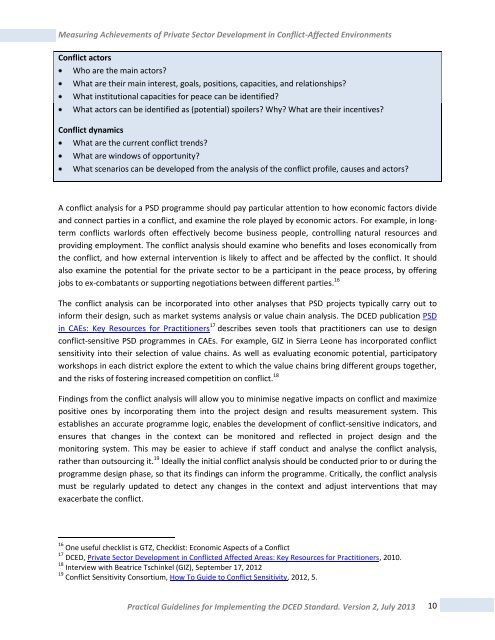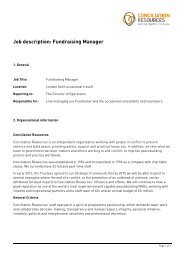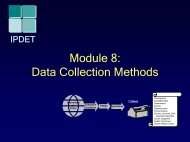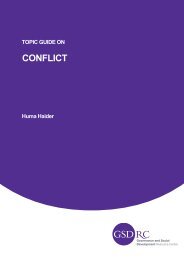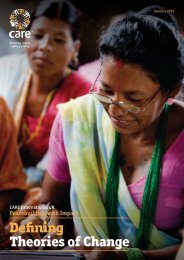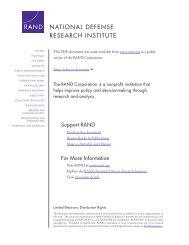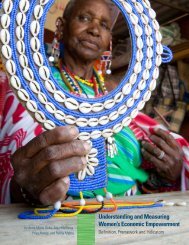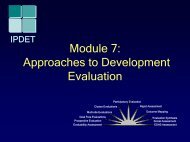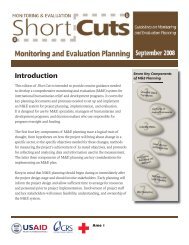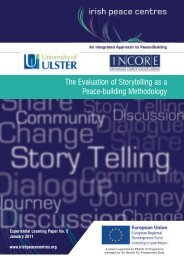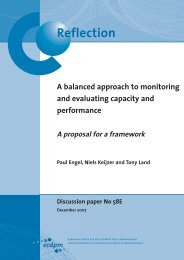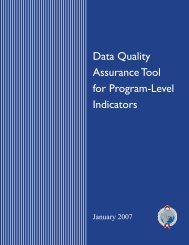Measuring Achievements of Private Sector Development in ... - DCED
Measuring Achievements of Private Sector Development in ... - DCED
Measuring Achievements of Private Sector Development in ... - DCED
Create successful ePaper yourself
Turn your PDF publications into a flip-book with our unique Google optimized e-Paper software.
<strong>Measur<strong>in</strong>g</strong> <strong>Achievements</strong> <strong>of</strong> <strong>Private</strong> <strong>Sector</strong> <strong>Development</strong> <strong>in</strong> Conflict-Affected Environments<br />
Conflict actors<br />
Who are the ma<strong>in</strong> actors<br />
What are their ma<strong>in</strong> <strong>in</strong>terest, goals, positions, capacities, and relationships<br />
What <strong>in</strong>stitutional capacities for peace can be identified<br />
What actors can be identified as (potential) spoilers Why What are their <strong>in</strong>centives<br />
Conflict dynamics<br />
What are the current conflict trends<br />
What are w<strong>in</strong>dows <strong>of</strong> opportunity<br />
What scenarios can be developed from the analysis <strong>of</strong> the conflict pr<strong>of</strong>ile, causes and actors<br />
A conflict analysis for a PSD programme should pay particular attention to how economic factors divide<br />
and connect parties <strong>in</strong> a conflict, and exam<strong>in</strong>e the role played by economic actors. For example, <strong>in</strong> longterm<br />
conflicts warlords <strong>of</strong>ten effectively become bus<strong>in</strong>ess people, controll<strong>in</strong>g natural resources and<br />
provid<strong>in</strong>g employment. The conflict analysis should exam<strong>in</strong>e who benefits and loses economically from<br />
the conflict, and how external <strong>in</strong>tervention is likely to affect and be affected by the conflict. It should<br />
also exam<strong>in</strong>e the potential for the private sector to be a participant <strong>in</strong> the peace process, by <strong>of</strong>fer<strong>in</strong>g<br />
jobs to ex-combatants or support<strong>in</strong>g negotiations between different parties. 16<br />
The conflict analysis can be <strong>in</strong>corporated <strong>in</strong>to other analyses that PSD projects typically carry out to<br />
<strong>in</strong>form their design, such as market systems analysis or value cha<strong>in</strong> analysis. The <strong>DCED</strong> publication PSD<br />
<strong>in</strong> CAEs: Key Resources for Practitioners 17 describes seven tools that practitioners can use to design<br />
conflict-sensitive PSD programmes <strong>in</strong> CAEs. For example, GIZ <strong>in</strong> Sierra Leone has <strong>in</strong>corporated conflict<br />
sensitivity <strong>in</strong>to their selection <strong>of</strong> value cha<strong>in</strong>s. As well as evaluat<strong>in</strong>g economic potential, participatory<br />
workshops <strong>in</strong> each district explore the extent to which the value cha<strong>in</strong>s br<strong>in</strong>g different groups together,<br />
and the risks <strong>of</strong> foster<strong>in</strong>g <strong>in</strong>creased competition on conflict. 18<br />
F<strong>in</strong>d<strong>in</strong>gs from the conflict analysis will allow you to m<strong>in</strong>imise negative impacts on conflict and maximize<br />
positive ones by <strong>in</strong>corporat<strong>in</strong>g them <strong>in</strong>to the project design and results measurement system. This<br />
establishes an accurate programme logic, enables the development <strong>of</strong> conflict-sensitive <strong>in</strong>dicators, and<br />
ensures that changes <strong>in</strong> the context can be monitored and reflected <strong>in</strong> project design and the<br />
monitor<strong>in</strong>g system. This may be easier to achieve if staff conduct and analyse the conflict analysis,<br />
rather than outsourc<strong>in</strong>g it. 19 Ideally the <strong>in</strong>itial conflict analysis should be conducted prior to or dur<strong>in</strong>g the<br />
programme design phase, so that its f<strong>in</strong>d<strong>in</strong>gs can <strong>in</strong>form the programme. Critically, the conflict analysis<br />
must be regularly updated to detect any changes <strong>in</strong> the context and adjust <strong>in</strong>terventions that may<br />
exacerbate the conflict.<br />
16 One useful checklist is GTZ, Checklist: Economic Aspects <strong>of</strong> a Conflict<br />
17 <strong>DCED</strong>, <strong>Private</strong> <strong>Sector</strong> <strong>Development</strong> <strong>in</strong> Conflicted Affected Areas: Key Resources for Practitioners, 2010.<br />
18 Interview with Beatrice Tsch<strong>in</strong>kel (GIZ), September 17, 2012<br />
19 Conflict Sensitivity Consortium, How To Guide to Conflict Sensitivity, 2012, 5.<br />
Practical Guidel<strong>in</strong>es for Implement<strong>in</strong>g the <strong>DCED</strong> Standard. Version 2, July 2013<br />
10


